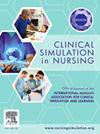Immersive virtual reality simulation versus screen-based virtual simulation: An examination of learning outcomes in nursing education
IF 3.4
3区 医学
Q1 NURSING
引用次数: 0
Abstract
Background
Immersive virtual reality (IVR) and screen-based (2D) virtual reality simulations are increasingly used in nursing education; however, research comparing their effectiveness is limited.
Method
This quasi-experimental study compared learning outcomes between IVR (n = 14) and screen-based (2D) virtual reality (n = 13) simulations among first-year nursing students. Both groups completed pre- and post-tests on orthopedic postoperative nursing management knowledge and a post-test survey on satisfaction and self-confidence.
Results
Both groups showed improvements in knowledge test scores, which were not statistically significant. The IVR group demonstrated significantly higher satisfaction and self-confidence scores compared to the screen-based group.
Conclusion
While both IVR and screen-based (2D) virtual reality simulations can effectively teach content, IVR may offer advantages in student engagement and confidence. Further research is needed to determine long-term outcomes and cost-effectiveness of IVR in nursing education.
沉浸式虚拟现实模拟与基于屏幕的虚拟模拟:护理教育学习成果的检验
沉浸式虚拟现实(IVR)和基于屏幕(2D)的虚拟现实模拟越来越多地应用于护理教育;然而,比较它们的有效性的研究是有限的。方法采用准实验研究的方法,比较护理一年级学生的IVR (n = 14)和基于屏幕的虚拟现实(n = 13)模拟的学习效果。两组均完成骨科术后护理管理知识的前后测试和术后满意度和自信心的调查。结果两组患者知识测试成绩均有改善,差异无统计学意义。与基于屏幕的组相比,IVR组表现出明显更高的满意度和自信心得分。虽然IVR和基于屏幕(2D)的虚拟现实模拟都可以有效地教授内容,但IVR可能在学生参与和信心方面具有优势。需要进一步的研究来确定IVR在护理教育中的长期效果和成本效益。
本文章由计算机程序翻译,如有差异,请以英文原文为准。
求助全文
约1分钟内获得全文
求助全文
来源期刊

Clinical Simulation in Nursing
NURSING-
CiteScore
5.50
自引率
15.40%
发文量
107
期刊介绍:
Clinical Simulation in Nursing is an international, peer reviewed journal published online monthly. Clinical Simulation in Nursing is the official journal of the International Nursing Association for Clinical Simulation & Learning (INACSL) and reflects its mission to advance the science of healthcare simulation.
We will review and accept articles from other health provider disciplines, if they are determined to be of interest to our readership. The journal accepts manuscripts meeting one or more of the following criteria:
Research articles and literature reviews (e.g. systematic, scoping, umbrella, integrative, etc.) about simulation
Innovative teaching/learning strategies using simulation
Articles updating guidelines, regulations, and legislative policies that impact simulation
Leadership for simulation
Simulation operations
Clinical and academic uses of simulation.
 求助内容:
求助内容: 应助结果提醒方式:
应助结果提醒方式:


